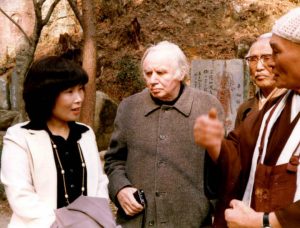My Life—Interview with Keiko Ogura (1937–), interpreter and A-bomb survivor, Part 7: Robert Jungk
May 6, 2023
Persuaded to make debut as interpreter
Still grieving the sudden death of my dear husband, I received a phone call from Robert Jungk. He told me he was to visit Hiroshima and asked me to interpret for him. I refused at first, saying my lack of experience as an interpreter made the job absolutely impossible. I had been a homemaker for such a long time that I had forgotten English. Mr. Jungk tried to convince me, telling me I was qualified for the work. He said I knew the grief of suddenly losing a loved one as well as the suffering of A-bomb survivors, pointing out that war and nuclear weapons were robbing people of their lives and causing them to suffer. He encouraged me to “use the grief as a stepping stone and try my best.”
In February 1980, Mr. Jungk, a German-born journalist of Jewish ancestry who had been making a tour of nuclear power plants around Japan, visited Hiroshima to report on the situation there for the first time in 10 years.
As soon as he arrived, Mr. Jungk insisted that I sit down in front of a group of intellectuals and peace activists and interpret for them. I was not knowledgeable at the time and could not even translate the term “nuclear power plant.” Mr. Jungk took me here and there, and I will never forget the moment he stood tall in front of the Cenotaph for the A-bomb Victims in Peace Memorial Park (located in Hiroshima’s Naka Ward) and shouted at the top of his lungs that he denounced nuclear weapons and shook with rage on behalf of the victims.
The next day, we paid a visit to Mitaki Temple (in Hiroshima’s Nishi Ward), accompanied by Ichiro Kawamoto, who made an appearance in Mr. Jungk’s famous publication on Hiroshima titled Brighter than a Thousand Suns, and Ichiro Moritaki, an A-bomb survivor who led the campaign against atomic and hydrogen bombs. At the temple, there is a memorial for Auschwitz victims, and Mr. Jungk, who lost his beloved family in the Holocaust, offered an earnest prayer at the monument.
I managed to handle the interpretation work for Mr. Jungk, but that was not to be the end of it. Journalists and scientists from overseas started contacting me one after another. Before I knew it, I had become busy coordinating visits and interpreting for visitors. Referring to dictionaries, I began studying English obsessively.
I turned the pages of a notebook that my late husband had left behind and found it to be filled with the contact information of scholars and peace activists who would be indispensable for the work of guiding people around Hiroshima. When I called them on the telephone and mentioned I was Kaoru Ogura’s wife, all kindly responded to my requests for help. My network of contacts grew rapidly. Seiji Imahori, Minoru Yuzaki, and Tomin Harada were some of the names. I learned so much while connecting visitors from overseas to such key people in the A-bombed city.
To provide for my family, I began teaching English at the YMCA and at vocational schools. I worked day and night, guiding overseas visitors in my spare time. I felt as if I had earned a name for myself for the first time, instead of being known as someone’s “wife.”
(Originally published on May 6, 2023)








